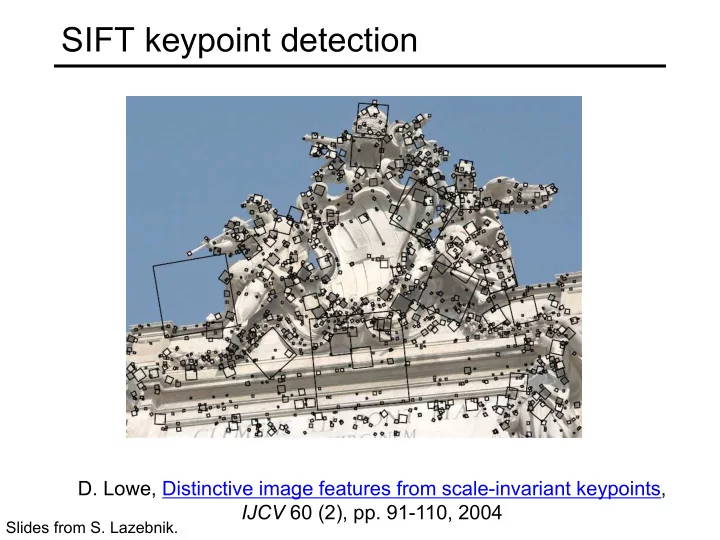

SIFT keypoint detection D. Lowe, Distinctive image features from scale-invariant keypoints, IJCV 60 (2), pp. 91-110, 2004 Slides from S. Lazebnik.
Keypoint detection with scale selection • We want to extract keypoints with characteristic scales that are covariant w.r.t. the image transformation Source: L. Lazebnik
Basic idea • Convolve the image with a “blob filter” at multiple scales and look for extrema of filter response in the resulting scale space T. Lindeberg, Feature detection with automatic scale selection, IJCV 30(2), pp 77-116, 1998 Source: L. Lazebnik
Blob detection minima = * maxima Find maxima and minima of blob filter response in space and scale Source: N. Snavely Source: L. Lazebnik
Blob filter Laplacian of Gaussian: Circularly symmetric operator for blob detection in 2D ¶ ¶ 2 2 g g Ñ = + 2 g ¶ ¶ 2 2 x y Source: L. Lazebnik
Recall: Edge detection Edge f d Derivative g of Gaussian dx d Edge = maximum f * g of derivative dx Source: S. Seitz Source: L. Lazebnik
Edge detection, Take 2 Edge f Second derivative 2 d of Gaussian g 2 dx (Laplacian) 2 d Edge = zero crossing * f g of second derivative 2 dx Source: S. Seitz Source: L. Lazebnik
From edges to blobs • Edge = ripple • Blob = superposition of two ripples maximum Spatial selection : the magnitude of the Laplacian response will achieve a maximum at the center of the blob, provided the scale of the Laplacian is “matched” to the scale of the blob Source: L. Lazebnik
Scale selection • We want to find the characteristic scale of the blob by convolving it with Laplacians at several scales and looking for the maximum response • However, Laplacian response decays as scale increases: original signal increasing σ (radius=8) Source: L. Lazebnik
Scale normalization • The response of a derivative of Gaussian filter to a perfect step edge decreases as σ increases: 1 s p 2 • To keep response the same (scale-invariant), must multiply Gaussian derivative by σ • Laplacian is the second Gaussian derivative, so it must be multiplied by σ 2 Source: L. Lazebnik
Effect of scale normalization Original signal Unnormalized Laplacian response Scale-normalized Laplacian response maximum Source: L. Lazebnik
Blob detection in 2D • Scale-normalized Laplacian of Gaussian: æ ö ¶ ¶ 2 2 g g ç ÷ Ñ = s + 2 2 g ç ÷ norm ¶ ¶ 2 2 x y è ø Source: L. Lazebnik
Blob detection in 2D • At what scale does the Laplacian achieve a maximum response to a binary circle of radius r? r image Laplacian Source: L. Lazebnik
Blob detection in 2D • At what scale does the Laplacian achieve a maximum response to a binary circle of radius r? • To get maximum response, the zeros of the Laplacian have to be aligned with the circle • The Laplacian is given by (up to scale): 2 2 2 - + s + - s 2 2 2 ( x y ) / 2 ( x y 2 ) e s = r / 2 . • Therefore, the maximum response occurs at circle r 0 Laplacian image Source: L. Lazebnik
Scale-space blob detector 1. Convolve image with scale-normalized Laplacian at several scales Source: L. Lazebnik
Scale-space blob detector: Example Source: L. Lazebnik
Scale-space blob detector: Example Source: L. Lazebnik
Scale-space blob detector 1. Convolve image with scale-normalized Laplacian at several scales 2. Find maxima of squared Laplacian response in scale-space Source: L. Lazebnik
Scale-space blob detector: Example Source: L. Lazebnik
Efficient implementation • Approximating the Laplacian with a difference of Gaussians: ( ) = s s + s 2 L G ( , , ) x y G ( , , ) x y xx yy (Laplacian) = s - s DoG G x y k ( , , ) G x y ( , , ) (Difference of Gaussians) Source: L. Lazebnik
Efficient implementation David G. Lowe. "Distinctive image features from scale-invariant keypoints.” IJCV 60 (2), pp. 91-110, 2004. Source: L. Lazebnik
Eliminating edge responses • Laplacian has strong response along edges Source: L. Lazebnik
Eliminating edge responses • Laplacian has strong response along edges • Solution: filter based on Harris response function over neighborhoods containing the “blobs” Source: L. Lazebnik
From feature detection to feature description • To recognize the same pattern in multiple images, we need to match appearance “signatures” in the neighborhoods of extracted keypoints • But corresponding neighborhoods can be related by a scale change or rotation • We want to normalize neighborhoods to make signatures invariant to these transformations Source: L. Lazebnik
Finding a reference orientation • Create histogram of local gradient directions in the patch • Assign reference orientation at peak of smoothed histogram 2 p 0 Source: L. Lazebnik
SIFT features • Detected features with characteristic scales and orientations: David G. Lowe. "Distinctive image features from scale-invariant keypoints.” IJCV 60 (2), pp. 91-110, 2004. Source: L. Lazebnik
From keypoint detection to feature description Detection is covariant : features(transform(image)) = transform(features(image)) Description is invariant : features(transform(image)) = features(image) Source: L. Lazebnik
SIFT descriptors • Inspiration: complex neurons in the primary visual cortex D. Lowe, Distinctive image features from scale-invariant keypoints, IJCV 60 (2), pp. 91-110, 2004 Source: L. Lazebnik
Properties of SIFT Extraordinarily robust detection and description technique • Can handle changes in viewpoint – Up to about 60 degree out-of-plane rotation • Can handle significant changes in illumination – Sometimes even day vs. night • Fast and efficient—can run in real time • Lots of code available Source: N. Snavely
Recommend
More recommend